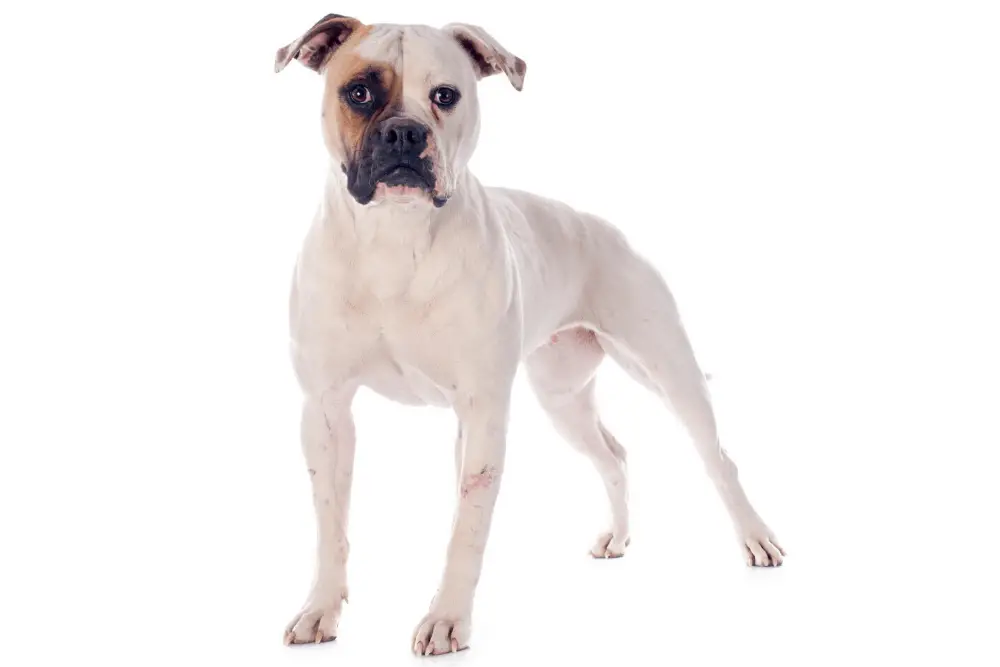Other Names: Country Bulldog, English White, Bulldog
Country Of Origin: USA
Dog Group: Working/guarding
Size: Large
Recommended For: Families, couples, single owners
Maintenance Level: Moderate
Lifespan: 10-15 years
Temperament: Loyal, protective, affectionate
FAQ
Good For the First-Time Owner: Sometimes
Good With Children: Yes
Good With Other Animals: Yes
Good With Strangers: Sometimes
Good For Apartments: No
Exercise Requirements: Daily walking
Can Live In Hot Weather: Yes
Can Live In Cold Weather: Yes
Can Tolerate Being Left Alone: Yes
Grooming: Moderate
Trainability: Moderate
Breed Overview:
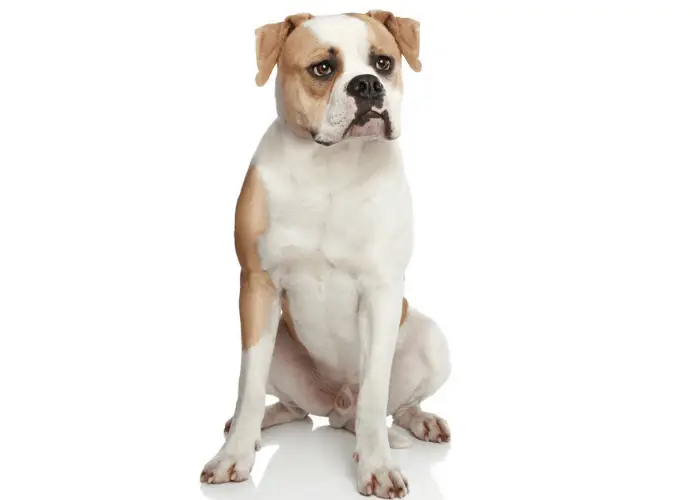
The American Bulldog is a large breed that’s mainly been used for working purposes. While Bulldogs are still used worldwide in utility roles, they’re also becoming increasingly popular as family dogs, thanks to their loyalty and affection.
Generally, American Bulldogs have a friendly temperament and make very good protection dogs.
Like many other Bulldog breeds, they have a reputation for being aggressive, but this simply isn’t true of this breed. Much of the American Bulldog’s potential aggression has long been bred out of them.
Color: All white, or white with patches of red, fawn, brindle, or brown
Height: Males – 20-26 inches, Females – 20-24 inches
Weight: Males – 70-120lbs, Females – 60-90lbs
Personality and Temperament:

American Bulldogs are very sociable and outgoing dogs and love to play. They thrive on human attention and love spending time with their family, whether this is out walking or sleeping at home.
The breed is known for being confident and energetic, making it a good choice for active owners.
For these reasons, the American Bulldog makes an ideal family pet. The breed is known for being very tolerant of children and loves to play with them, and this is true of both younger and older kids.
However, American Bulldogs should be socialized with children as early as possible, and if you plan to adopt one, just make sure it’s been raised around kids.
When it comes to other dogs, American Bulldogs are generally fine. While this will vary between dogs, proper socialization and training should make them absolutely fine around other animals.
Just remember that the breed was used for catching vermin and so may retain some prey drive.
Training is vital if owners want to get the most out of their American Bulldog. Aside from the obvious obedience, training classes also let the Bulldog socialize with other dogs from a young age, which is necessary for a well-behaved adult.
American Bulldogs are quite intelligent dogs, so they are capable of learning a range of commands. However, owners need to be confident with training because the breed can be quite cheeky.
American Bulldogs are often used as guard dogs, and this is a strength that was bred into them a long time ago.
As a result, they have a very strong natural guarding instinct and can be trained to be very effective out of this. American Bulldogs aren’t generally aggressive but will bark to alert owners.
Due to their other major use as working animals, American Bulldogs are very energetic. They need plenty of exercise every day and should be walked for at least an hour.
Bulldogs also love playing fetch and tug, so they should be offered plenty of playtimes because this is great mental stimulation and bonding time.
American Bulldogs aren’t the best breed for apartment living, both because of their size and energy levels.
They’re much better suited to a house with a back yard, but are suitable for urban living, providing there’s somewhere big to exercise nearby.
Although American Bulldogs make great family pets, they’re not the best choice for first-time owners.
The main reason is that they can be difficult to control, particularly if not trained properly, and would do much better with an experienced and confident owner.
However, American Bulldogs will be fine for first-time owners that will work hard to raise them properly.
While American Bulldogs are great watchdogs, this protective nature does carry across to all strangers.
Bulldogs can often be wary of strangers, even to the point that they growl. However, American Bulldogs generally won’t bark unless they need to alert their owners, and this wary nature can be improved with proper socialization and training.
American Bulldogs generally do well in all weather conditions, mainly because they were used across all of the USA and so had to be suitable for different climates.
Owners won’t have to worry as much about overheating in the summer, but should still take care with how much exercise they give when it’s hot.
Also, American Bulldogs might need an extra coat if it gets really cold in the winter because their fur is quite short.
The American Bulldog’s role as a guard dog meant that it would be left alone for long periods of time while working.
This means that the breed is much more tolerant of being left alone while owners are at work. However, a proper routine is still important as this will stop potential destructive behavior while you’re out.
Grooming
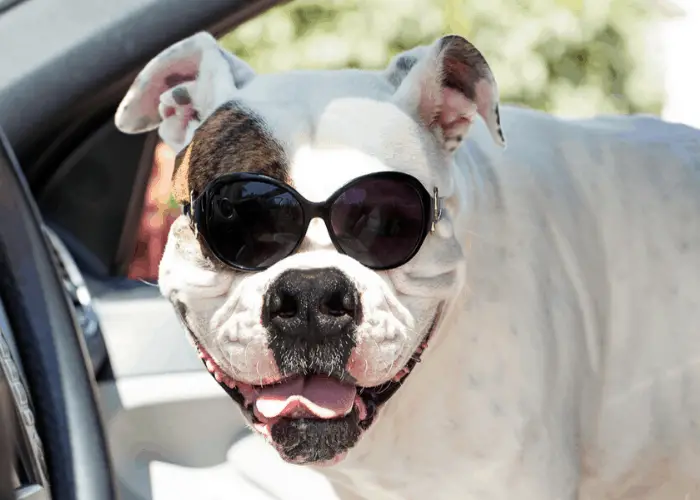
American Bulldogs have a short coat that’s quite soft. It feels stiffer around the neck and shoulders where it’s thickest, and this is also where most of the shedding comes from.
However, American Bulldogs generally don’t shed all that much, although this can change around spring.
The easiest way to look after an American Bulldog’s coat is a quick weekly brushing with a soft-bristle brush or rubber mitt.
More than anything, this helps distribute oils through the coat, which keeps it shiny. Bathing isn’t necessary unless the dog rolls in something stinky.
Owners should check the dog’s ears every week or so, just to make sure there’s no debris in them.
This isn’t a massive problem for American Bulldogs, but some can have very open ears, which does increase the risk. If they ever look dirty, just clean them with a piece of damp cotton wool.
As with any dog, an American Bulldog’s nails need to be trimmed regularly, although this won’t be as necessary if they get enough exercise.
Also, cleaning their teeth several times a week is important to minimize dental problems.
Common Diseases and Conditions:
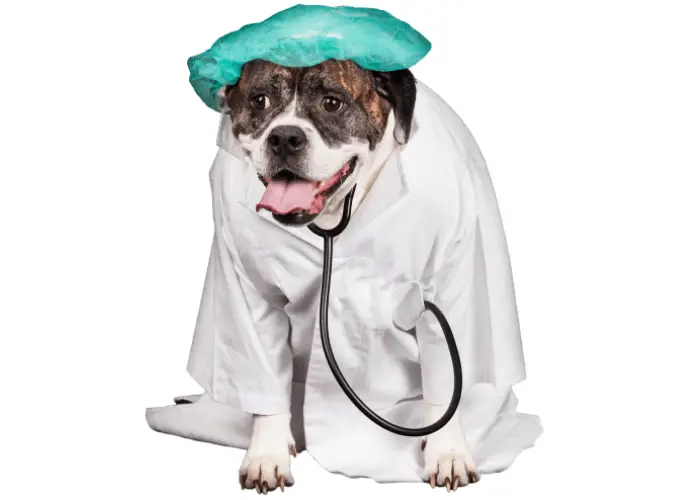
Overall, American Bulldogs are a very healthy breed. This is mainly because they’re not recognized by major kennel clubs, and so don’t have as strict breed standards.
Interestingly though, this means they have different common hereditary problems to many other breeds.
A common problem for American Bulldogs is a cherry eye, which is also known as a third eyelid.
This isn’t considered a genetic problem, but the breed is more prone to it. Providing it’s caught early enough, cherry eye can be treated without surgery, and while the condition itself isn’t necessarily harmful, it can lead to a range of secondary complications.
American Bulldogs are also prone to a number of neurological problems, many of which are caused by selective breeding, which has shrunk their skull. Like other breeds, this puts pressure on their brain and can lead to various issues.
A common issue is called neuronal ceroid lipofuscinosis, which is a name given to several different conditions.
They call affect memory centers and are genetic. However, responsible American Bulldog breeders test for these conditions and are working to reduce their rates in the breed.
History:
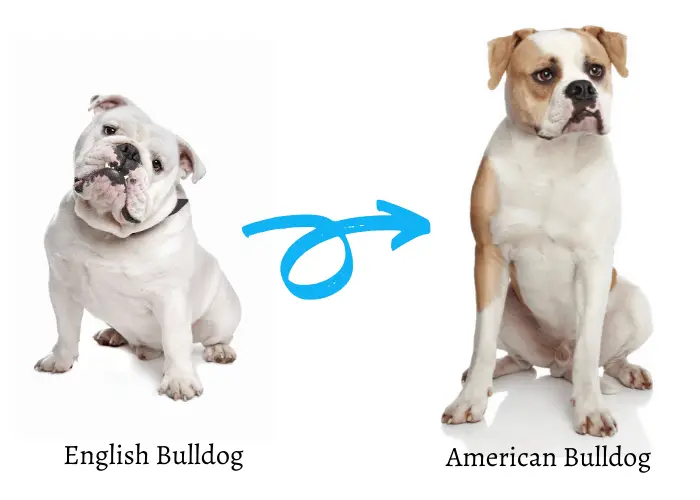
The American Bulldog descends from the Old English Bulldog, which was brought over to America as a working dog.
It was mainly used in the American South for things like livestock herding and guarding, vermin catching, and property protection.
Another major role for the dogs was hunting wild pigs, which was the reason it became so useful in the South.
At this time there weren’t official breed standards, and it wasn’t known as the American Bulldog. In fact, the breed essentially descends directly from the Old English Bulldog and its name changed naturally over time.
By the middle of the 20th century, the American Bulldog was almost extinct, which was thanks mainly to the introduction of technology that filled its roles.
However, a man named John D. Johnson worked hard to find the best breeding dogs in order to save them.
Another man, Alan Scott, then joined in and crossbred some new Bulldogs into the mix for genetic variety.
The two men worked together to revive the American Bulldog breed, which then split into 2 types: the Scott type (the standard), and the Johnson type (now the American Bully).
American Bulldogs currently aren’t recognized by the AKC, but they are becoming more popular in dog shows. However, their main role now is as a family dog, which is something they’re very good at.
Facts:
- The American Bulldog and the Pit bull aren’t the same dogs. American Bulldogs are broader than the Pit bull breeds and usually have shorter noses.
- American Bulldog puppies are born with their markings already on their skin, which can be seen through their fur.
- American Bulldogs have appeared in a number of movies, including Tucker and Dale vs. Evil, Homeward Bound 1 and 2, and The Little Rascals.
- Similarly, Spike and Tyke from Tom and Jerry are American Bulldogs.
- Because there are no real official breed standards, American Bulldogs can vary massively in size and weight. Also, the American Bully is much heavier than the original breed.

